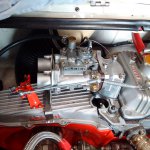This is inspired by the pictures in the recent post by ClassicFiat500 about his backfiring hot rod. I was taken by the absolute overkill look of the Weber side draft on top of the tiny engine.
I had the following idea for my -59 Bianchina, the one that I'm hot rodding. Or maybe "warm rodding" is a better phrase? (The -58 Nuova will stay as original as possible.)
I have a small stash of vintage Weber DCOE and Dellorto carbs, and instead of 28/32 or similar I'm thinking of using only one of the barrels of a 40mm side draft carb to supply the engine, and block off the other barrel. Kind of like the split-Weber setup they used on some racing Mini Coopers. I'm thinking of using the nice Alfa "rubbers" to connect, but I would have to fabricate an elbow for the intake, brackets etc.
Has anybody tried a similar setup before, and if so, what were the results? Any big "gotchas"? More importantly, is this a really dumb idea?
Please encourage or discourage!
I had the following idea for my -59 Bianchina, the one that I'm hot rodding. Or maybe "warm rodding" is a better phrase? (The -58 Nuova will stay as original as possible.)
I have a small stash of vintage Weber DCOE and Dellorto carbs, and instead of 28/32 or similar I'm thinking of using only one of the barrels of a 40mm side draft carb to supply the engine, and block off the other barrel. Kind of like the split-Weber setup they used on some racing Mini Coopers. I'm thinking of using the nice Alfa "rubbers" to connect, but I would have to fabricate an elbow for the intake, brackets etc.
Has anybody tried a similar setup before, and if so, what were the results? Any big "gotchas"? More importantly, is this a really dumb idea?
Please encourage or discourage!




